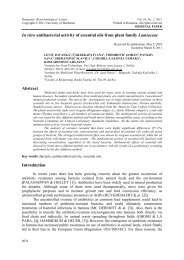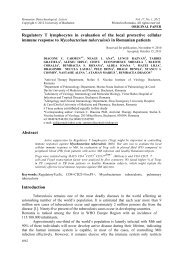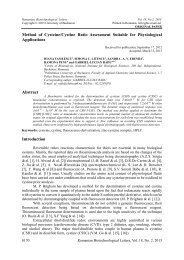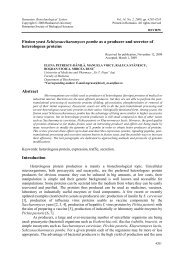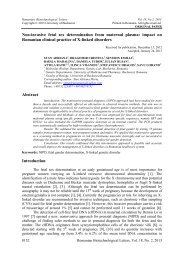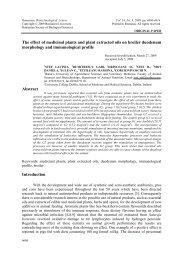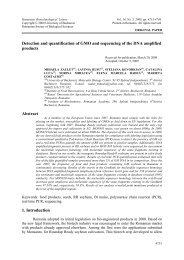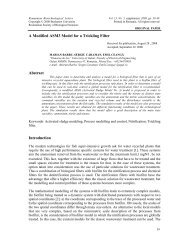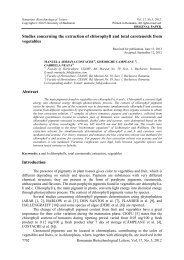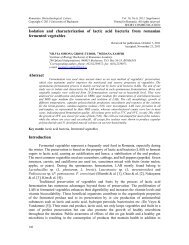Phylogenetic analysis of oil polluted soil microbial strains - Rombio.eu
Phylogenetic analysis of oil polluted soil microbial strains - Rombio.eu
Phylogenetic analysis of oil polluted soil microbial strains - Rombio.eu
Create successful ePaper yourself
Turn your PDF publications into a flip-book with our unique Google optimized e-Paper software.
Romanian Biotechnological Letters Vol. 17, No.2, 2012<br />
Copyright © 2012 University <strong>of</strong> Bucharest<br />
Printed in Romania. All rights reserved<br />
ORIGINAL PAPER<br />
<strong>Phylogenetic</strong> <strong>analysis</strong> <strong>of</strong> <strong>oil</strong> <strong>polluted</strong> s<strong>oil</strong> <strong>microbial</strong> <strong>strains</strong><br />
Received for publication, November 25, 2011<br />
Accepted, March 20, 2012<br />
ANA-MARIA TANASE, TATIANA VASSU, ORTANSA CSUTAK, DIANA<br />
PELINESCU, IONESCU ROBERTINA , ILEANA STOICA * .<br />
Faculty <strong>of</strong> Biology, University <strong>of</strong> Bucharest, Bucharest, Romania<br />
*Author to whom correspondence should be addressed: E-Mail; prutu@yahoo.com;<br />
geneticuss@yahoo.com<br />
Tel: + 40213118077<br />
Abstract:<br />
Several biological technologies using natural or specialized microorganisms<br />
have been developed for the cleanup <strong>of</strong> <strong>oil</strong>y sludge and <strong>oil</strong>-contaminated<br />
environments . As an adaptative behaviour <strong>of</strong> these environments, bacterial<br />
chemotaxis is a sophisticated information-processing capabilities requires that<br />
cause motile bacteria to either move towards from different carbon souces like<br />
crude <strong>oil</strong>, phenol, quinoline, n-hexadecane. Physiological and biochemical tests<br />
on newly isolated <strong>strains</strong> confirmed taxonomic identification based on 16S<br />
DNA sequences, as followed: Acinetobacter radioresistence SQ3 and SQ10,<br />
Rhodococcus fasciens SQ8, Ps<strong>eu</strong>domonas putida SQ9 and Acidovorax avenae<br />
SQ11. Presence <strong>of</strong> rich plasmid content <strong>of</strong> bacterial <strong>strains</strong> can be correlated<br />
with biodegradation potential revealed by chemotaxis assayand antibiotic<br />
sensitivity.<br />
Key words: biodegradation, phylogenetic tree, 16S, chemotaxis, Biolog;<br />
Introduction<br />
Oil pollution is an environmental problem <strong>of</strong> increasing importance, <strong>of</strong> modern society.<br />
The contamination <strong>of</strong> the environment with <strong>oil</strong> and <strong>oil</strong> products is detrimental to the<br />
ecological situation <strong>of</strong> local environments[2,5,6]. To achieve best results in environmental<br />
polution, biodegradation <strong>of</strong> hydrocarbons by microorganisms may represent one <strong>of</strong> the<br />
remediation mechanisms by which these pollutants can be eliminated from the contaminated<br />
field sites. The major advantages <strong>of</strong> <strong>microbial</strong> degradation methodes compared with different<br />
alterative technologies, such as incineration or chemical extraction, are lower cost, greater<br />
safety, and less environmental disturbance[10,13,21]. As hydrocarbon-utilizing<br />
microorganisms are mostly found in nature, petrol<strong>eu</strong>m pollutants result in an increase in the<br />
hydrocarbon-oxidizing potential organisms. Several biological technologies using natural or<br />
specialized microorganisms have been developed for the cleanup <strong>of</strong> <strong>oil</strong>y sludge and <strong>oil</strong>contaminated<br />
environments [13,10,6].<br />
However, each individual strain is usually characterized by an ability to utilize only a<br />
few kinds <strong>of</strong> hydrocarbons. As the hydrocarbon mixtures markedly differ in volatility,<br />
solubility, and susceptibility to degradation, the required consortium <strong>of</strong> enzymes cannot be<br />
found in a single microorganism. Therefore, mixed culturing <strong>of</strong> <strong>microbial</strong> community, via<br />
Romanian Biotechnological Letters, Vol. 17, No. 2, 2012<br />
Romanian Biotechnological Letters, Vol. 17, No. 2, 2012<br />
7093
ANA-MARIA TANASE, TATIANA VASSU, ORTANSA CSUTAK,<br />
DIANA PELINESCU, IONESCU ROBERTINA , ILEANA STOICA<br />
enrichment cultures, has been usually suggested by previous research for complete<br />
biodegradation <strong>of</strong> <strong>oil</strong> pollutants [10,12,13].<br />
The main challenge in biological remediation <strong>of</strong> hydrocarbon compounds is their<br />
extremely low solubility in water. One <strong>of</strong> the approaches to enhance the biodegradation <strong>of</strong><br />
hydrocarbon pollutants is using natural biosurfactants or external chemical additions that<br />
could increase the solubility <strong>of</strong> hydrocarbon pollutants in water, obtaining higher degradation<br />
rates [5,6,].<br />
Microbial biodegradation is known to be an efficient process in the decontamination<br />
<strong>of</strong> <strong>oil</strong>-<strong>polluted</strong> environments. First step in establishing in situ bioremediation potential<br />
includes search for <strong>oil</strong> degrading indigenous microorganisms.In this study, the degradation<br />
potential was accompanied by evaluation <strong>of</strong> chemotaxis responce and taxonomic<br />
identification <strong>of</strong> some <strong>strains</strong> isolated from <strong>oil</strong> and <strong>oil</strong> <strong>polluted</strong> s<strong>oil</strong>.<br />
Materials and methods<br />
Sampling and <strong>strains</strong> isolation: S<strong>oil</strong> sample was taken from nearby <strong>of</strong> an out <strong>of</strong><br />
function <strong>oil</strong> pomp. Started with 1g s<strong>oil</strong> was performed enrichment culture on liquid MSM<br />
(Mineral Salts Medium: potassium hydrogenphosphate 1g, potassium dihydrogenphosphate<br />
0.5g, magnesium sulphate 0.2g, sodium chloride 1g, ammonium sulphate 1g, distillated water<br />
1000ml) supplemented with 1% crude <strong>oil</strong> microbiological free as unique carbon source, by<br />
incubation during 24h at 28 0 C and orbital agitation at 250rpm. From the enrichment culture<br />
were isolated pure <strong>strains</strong> by inoculated solid LB (peptone 10g, yeast extract 5g, sodium<br />
chloride 10g, agar 20g, pH 7-7,5) medium in Petri dishes. Enrichment culture and isolated<br />
<strong>strains</strong> were preserved in liquid LB medium supplemented with 20% glycerol at -70 o C in the<br />
Microbial Collection <strong>of</strong> MICROGEN (Center for Research, Consulting and Training in<br />
Microbiology, Genetics and Biotechnology), Department <strong>of</strong> Genetics, Faculty <strong>of</strong> Biology,<br />
University <strong>of</strong> Bucharest.<br />
Chemotaxis assay: Chemotaxis behaviors <strong>of</strong> strain all <strong>strains</strong> were tested by drop assay<br />
as described in the research <strong>of</strong> strain SJ98 [22], with a slight modification. The cells were<br />
grown to mid-logarithmic phase in LB medium and then washed twice with MSM to an<br />
OD600 <strong>of</strong> 5.0 (about 6.5 × 10 9 CFU) before pouring 100µl cells culture into solid MSM Petri<br />
plates. The chemotactic response was determined by placing the 10 μl substrates on sterile<br />
filter paper in the center <strong>of</strong> the plate at room temperature (25°C), with no substrate as the<br />
negative control. The formation <strong>of</strong> cellular growth was observed after 14 days <strong>of</strong> incubation.<br />
All assays were done thrice separately, with similar results obtained, and a representative<br />
example was described.<br />
Physiological and Biochemical Tests:<br />
•Assessing the ability to reduce nitrate: Liquid 18h cultures were inoculated on IM-1<br />
(potassium nitrate 1.5 g, nutrient broth 1.2 g, distillated water 150 ml pH 7.4, using Durham<br />
tubes). Results estimation was performed at 24, 48, 72 h using Ilesha – Gris solution I<br />
(sulphanilic acid 0.8 g / acetic acid 5N 100 ml) and solution II (α-naphtil-amine 0.5 g / acetic<br />
acid 5N 100 ml), and also powder Zn by evaluation for several times and also NO 2<br />
−<br />
Analytical Test Stripes (Merck). Positive test strain was Ps<strong>eu</strong>domonas aeruginosa GMQ-1.<br />
•Assessing the ability <strong>of</strong> casein hydrolysis: Solid 18h cultures were inoculated on IM-2<br />
(milk fat free 150ml, agar 5g, distillated water 200ml) plates by scratching method. After<br />
incubation at 28 o C from 2 to 14 days, formation <strong>of</strong> a cleared zone around the colonies<br />
7094 Romanian Biotechnological Letters, Vol. 17, No. 2, 2012<br />
Romanian Biotechnological Letters, Vol. 17, No. 2, 2012 6937
<strong>Phylogenetic</strong> <strong>analysis</strong> <strong>of</strong> <strong>oil</strong> <strong>polluted</strong> s<strong>oil</strong> <strong>microbial</strong> <strong>strains</strong><br />
indicated a positive reaction. Positive test strain was Ps<strong>eu</strong>domonas aeruginosa GMQ-1 and<br />
negative test strain was Agrobacterium tumefaciens.<br />
•Assessing the ability <strong>of</strong> starch hydrolysis: Liquid 18h cultures were inoculated by<br />
scratching on IM – 3 (soluble starch 2.5 g, nutrient broth 2 g, agar 5 g, distillated water 250<br />
ml) plates. After incubation at 28 o C for 48h, formation <strong>of</strong> a cleared zone around the colonies<br />
in presence <strong>of</strong> Lugol solution (Iodine in potassium iodinate) indicated a positive reaction.<br />
Positive test strain was Bacillus globigii amy + and negative test strain was Ps<strong>eu</strong>domonas<br />
aeruginosa GMQ-1.<br />
•Assessing the ability <strong>of</strong> gelatin hydrolysis: Solid 18h cultures was inoculated on IM – 4<br />
(gelatin 1.2 g Merck, nutrient broth 2.4 g, agar 6 g, distillated water 300 ml, pH 7 – 7.2). After<br />
incubation at 28 o C for 2-14 days, test evaluation was made by incubation for few hours to<br />
4 o C, if culture medium remained liquid the reaction was positive. Positive test strain was<br />
Bacillus subtilis and negative test strain was E. coli K12 NM522.<br />
•Assessing the ability <strong>of</strong> lipase production: Solid 18h cultures was inoculated on IM – 5<br />
(peptone 15 g, yeast extract 5 g, sodium chloride 5g, tributyrine 5 g, distillated water 1000<br />
ml). After incubation at 28 o C for 2-14 days tributyrine hydrolysis determined a cleared zone<br />
around the colonies. Positive test strain was Ps<strong>eu</strong>domonas aeruginosa GMQ-1 and negative<br />
test strain was Sacharomyces cerevisiae S288C.<br />
•Assessing the ability <strong>of</strong> L-lysine -decarboxilase production<br />
Liquid 18h cultures was inoculated in IM – 6 (peptone 1.25g, glucose 0.25g, yeast<br />
extract 0.75g, brom cresol purple 5mg, distillated water 250ml, and L-lysine 0.5%, pH 6.5),<br />
for each strain a standard tub L-lysine free was made. After 4 days incubation at 28C, in case<br />
<strong>of</strong> decarboxilation <strong>of</strong> lysine, media had turned purple determined by increasing pH values.<br />
Negative test strain was Ps<strong>eu</strong>domonas aeruginosa GMQ-1.<br />
•Assessing the ability <strong>of</strong> indole production: Liquid 18h cultures was inoculated in IM –<br />
7 (tryptone 2.5 g, sodium chloride 1.25 g, distillated water 250ml, pH 7.2 ). After incubation<br />
at 28 o C for 24-48h evaluation was made using, Ehrlich – Bohme solution (di-metil-aminobenzaldehide<br />
4 g, ethanol 380 ml and high purity chloride acid 80ml), few dopes <strong>of</strong> xilol were<br />
needed. Appearance <strong>of</strong> a red circle indicated the presence <strong>of</strong> indole in the culture medium.<br />
Negative test strain was Ps<strong>eu</strong>domonas aeruginosa GMQ-1.<br />
•Assessing the ability <strong>of</strong> reducing hydrogen sulphite: Liquid 18h cultures were<br />
inoculated in IM – 8 (iron sulfate 50 mg, sodium tiosulfate 75 mg, nutrient broth 2 g, water<br />
200 ml pH 7.2). After incubation for 1-2 days, formation <strong>of</strong> iron sulphite followed by back<br />
color appearance medium, was interpreted as positive reaction. Positive test strain was<br />
Ps<strong>eu</strong>domonas aeruginosa GMQ-1.<br />
•Assessing the ability <strong>of</strong> using citrate as carbon source: Solid 18h cultures was<br />
inoculated on MI – 9 Simmons medium (ammonium dehydrogenate phosphate 0.25g,<br />
potassium dehydrogenate phosphate 0.25 g, sodium citrate 1.25 g, magnesium sulphate 50<br />
mg, sodium chloride 1.25g, agar 5g, water 250 ml pH 7, bromthymol blue 8 ml from 1%<br />
solution) tubes. After few days incubation at 28 o C , appearance <strong>of</strong> green to blue color was a<br />
positive reaction. Positive test strain was Ps<strong>eu</strong>domonas aeruginosa GMQ-1 and negative test<br />
strain was E. coli K12 NM522.<br />
•Pigments production (pyocyanine, pyoverdine and fluoresceine) specific for<br />
Ps<strong>eu</strong>domonadaceae: Solid 18h cultures was inoculated on Ps<strong>eu</strong>domonas Agar P Base<br />
(peptone 20 g, magnesium chloride 1,4 g, potassium sulfate 10 g, glycerol 10 ml, agar 12,6 g,<br />
distillated water 1000ml, pH 7,1 ) plates and Ps<strong>eu</strong>domonas Agar F Base (peptone from casein<br />
10 g, peptone from meat 10 g, magnesium sulfate 1,5 g, di-potassium hydrogen phosphate<br />
1,5 g, glycerol 10 ml, agar 12 g, water 1000 ml, pH 7,1) plates. After incubation at 28C for<br />
one week, appearance <strong>of</strong> blue to green surrounding zone was due to pyocyanin formation, red<br />
Romanian Biotechnological Letters, Vol. 17, No. 2, 2012<br />
7095<br />
6938<br />
Romanian Biotechnological Letters, Vol. 17, No. 2, 2012
ANA-MARIA TANASE, TATIANA VASSU, ORTANSA CSUTAK,<br />
DIANA PELINESCU, IONESCU ROBERTINA , ILEANA STOICA<br />
to dark brown zone was due to pyorubin production by cultivation on Ps<strong>eu</strong>domonas Agar P<br />
Base but yellow to greenish-yellow zone was due to fluorescein production on Ps<strong>eu</strong>domonas<br />
Agar F Base.<br />
Plasmid DNA <strong>analysis</strong>: Plasmid DNA was isolated and purified using a modified<br />
alkaline-lyses technique (Birnboin Dolly). The lysozyme concentration in TEG buffer (Tris<br />
25mM, EDTA 10mM, glucose 50mM, pH 8.0) was 30mg/ml for the <strong>strains</strong> studied in this<br />
paper and 10mg/ml for E. coli V517, used as molecular marker strain. Also a kit extraction<br />
was performed using a Promega –Wizard Plus Minipreps DNA purification System.<br />
Biolog MicroPlates identification: Biolog MicroLog Identification: Each bacterial<br />
isolate was transferred onto LB agar plates and incubated for at least 7 days at 28°C. Plates<br />
were subsequently observed for bacterial growth and basic morphological characteristics,<br />
such as colony pigmentation, size and texture. Gram staining was performed and also<br />
microscopic cell morphology was verified. All isolates were prepared according to the<br />
manufacturer's instructions <strong>of</strong> MicroLog System (Biolog, Hayward, CA, USA). Each isolate<br />
was grown at 28°C on Biolog Universal Growth (BUG) agar. After 18–24h incubation<br />
bacterial biomass was emulsified to the specified cell density in the inoculating fluid (0.40%<br />
sodium chloride, 0.03% Pluronic F-68, and 0.02% Gellan Gum). Suspension was<br />
subsequently used to inoculate culture wells <strong>of</strong> GN/GP Microplates (Biolog, Hayward, CA).<br />
For all isolates, each well <strong>of</strong> the GP or GN Microplate was inoculated with 150 μl <strong>of</strong> the<br />
bacterial suspension.<br />
Antibioresistence test: Strains were initially identified by above microbiological<br />
methods gram staining, Biolog Microlog and by the API45NE biochemical system<br />
(BioMèri<strong>eu</strong>x, France) according to manufactures instructions. Antibiotic susceptibility was<br />
tested by disk diffusion methods according to the CLSI (formerly National Committee for<br />
Clinical Laboratory Standards, NCCLS 2000a,b) with the following modifications: plates <strong>of</strong><br />
LB agar media were used and were incubated at 28 °C for 2-4days. Standard antibiotic disks<br />
with specific antibiotic concentration were used (BioMèri<strong>eu</strong>x, Marcy l'Et<strong>oil</strong>e, France).<br />
PCR amplification <strong>of</strong> bacterial 16S rRNA genes: was performed using 1µl bacterial<br />
culture for 18 h at 28°C. DNA primers GM3f 8 (5’AGA GTT TGA TC(A/C) TGG C3’) and<br />
GM4r 1503 (5’TAC CTT GTT ACG ACT T3’), were used in a 50µl reaction mixture<br />
containing: 1X Taq Buffer, BSA 3mg/ml, 200µM <strong>of</strong> each deoxynucleotide triphoshpate,<br />
50µM <strong>of</strong> both primers and 1U Red-Taq DNA-Polymerase. An initial denaturating step <strong>of</strong><br />
94 o C for 10 minutes was followed by 29 cycles <strong>of</strong> amplification (1 min 94 o C, 2 min 50 o C, 3<br />
min 72 o C), and a final extension step at 72 o C for 5 min. Amplified DNA was electrophoresed<br />
on a 1% agarose gel, SB1X buffer and visualized using ethidium bromide .<br />
PCR amplicon cloning: PCR products were purified using a Sephadex G-50 Superfine,<br />
Amersham Millipore column and then were cloned in the Escherichia coli strain JM 109<br />
using TOPO TA Cloning Kit Invitrogen. Clones were selected by cultivation on LP-IPTG-X-<br />
Gal-Amp100 and the white colonies checked for correct insert size, randomly, and by vectortargeted<br />
primers PCR and gel electrophoresis.<br />
Sequencing and phylogenetic <strong>analysis</strong>: Sequencing was performed with the Big Dye<br />
Terminator Cycle Sequencing Reaction Kit (APPLIED BIOSYSTEMS) and primers M13F<br />
(5’GTA AAA CGA CGG CCA G3’) [19], M13R (5’CAG GAA ACA GCT ATG AC 3’)<br />
[19], GM1 (5’ CCA GCA GCC GCG GTA AT 3’), on automated Applied Biosystems DNA<br />
7096 Romanian Biotechnological Letters, Vol. 17, No. 2, 2012<br />
Romanian Biotechnological Letters, Vol. 17, No. 2, 2012 6939
<strong>Phylogenetic</strong> <strong>analysis</strong> <strong>of</strong> <strong>oil</strong> <strong>polluted</strong> s<strong>oil</strong> <strong>microbial</strong> <strong>strains</strong><br />
sequencer 3100 (ABI prism). In order to obtained full length sequences, was used Sequencer<br />
4.0 program, and then analyzed using Basic Local Alignment Search Tool (BLAST) program<br />
at the National Center for Biotechnology Information and the Sequence Match and the<br />
Classifier programs <strong>of</strong> the Ribosomal Database Project II. For construction <strong>of</strong> a phylogenetic<br />
tree the sequences were aligned with known bacterial 16S RNAs obtained from the GenBank<br />
database by using ARB s<strong>of</strong>tware package. <strong>Phylogenetic</strong> trees parsimony, neighbor-joining,<br />
and maximum-likelihood <strong>analysis</strong> with different sets <strong>of</strong> filters were calculated [6, 16].<br />
Nucleotide sequence accession numbers: The nucleotide sequence data reported in this paper<br />
will appear in the NCBI nucleotide sequence databases [3] under the accession no.<br />
DQ366086, DQ366088, DQ366089, DQ366090.<br />
Results and discussions<br />
Isolation: A number <strong>of</strong> this study was conducted only on. A set <strong>of</strong> <strong>strains</strong> 13 <strong>strains</strong> were<br />
isolated from enrichment culture having quinoline as carbon source, (Table 1)but only 5 <strong>of</strong><br />
them, named: SQ3, SQ10, SQ8, SQ9, SQ11was analysed for their chemotactic response to<br />
crud <strong>oil</strong>, standard <strong>oil</strong>, quinoline, phenol and n-hexadecane chemotaxis assays. In these<br />
qualitative assays a drop containing the attractant is brought into contact with a bacterial<br />
suspension. The accumulation <strong>of</strong> bacteria around the drop is a measure <strong>of</strong> chemotaxis. (Table<br />
1). Two patterns <strong>of</strong> accumulation were observed: one in which cells accumulated at a<br />
distance <strong>of</strong> 1–2 mm from the crude <strong>oil</strong> drop, (strain SQ3, SQ10 and SQ8, Fig. 1a ). The<br />
second pattern was characterized by an accumulation <strong>of</strong> cells on the n-hexadecane or crud<br />
<strong>oil</strong>(SQ8, Fig 1b and c). This phenotypes was asocciated with strong chemotaxis or<br />
hyperchemotaxis metabolism in many studies aspecially for Ps<strong>eu</strong>domonas putida<br />
[13,16,27]but not for Acinetobacter and Alcanivorax <strong>strains</strong>. The chemotactic response to<br />
increded concentrations <strong>of</strong> aromatic and aliphatic compounds <strong>of</strong> our newly isolated <strong>strains</strong><br />
was observed when cells were grown in rich Luria–Bertani (LB) medium or in MSM minimal<br />
medium with different carbon sources in the absence and in the presence <strong>of</strong> xenobiotic carbon<br />
sources, what indicates that this chemotactic response is <strong>of</strong> constitutive nature [13].<br />
Table 1. Growth <strong>of</strong> bacterial <strong>strains</strong> on various <strong>oil</strong>/ hydrocarbons as sole carbon source (+ = colonies<br />
formation; clear zone = circle around the filter paper disc where the concentration <strong>of</strong> carbon source was high and<br />
no colonies was grown ; ++++ = )<br />
Strain/Carbon source<br />
natural<br />
crude <strong>oil</strong><br />
standard<br />
fluka <strong>oil</strong><br />
quinoline phenol n-hexadecane<br />
.<br />
SQ3 ++++ ++<br />
SQ10 ++++ +++<br />
SQ8 ++++ ++<br />
++ clear zone<br />
d=20mm<br />
++ clear zone<br />
d=48mm<br />
++ clear zone<br />
d=25mm<br />
SQ9 ++ ++ -<br />
SQ11<br />
+ few<br />
colonies<br />
++ clear zone<br />
d=25mm<br />
++ clear zone<br />
d=52mm<br />
++ clear zone<br />
d=40mm<br />
++++<br />
+++<br />
+ clear zone d=67mm ++++<br />
++without<br />
clear zone<br />
+ few colonies<br />
- - +++<br />
Romanian Biotechnological Letters, Vol. 17, No. 2, 2012<br />
7097<br />
6940<br />
Romanian Biotechnological Letters, Vol. 17, No. 2, 2012
ANA-MARIA TANASE, TATIANA VASSU, ORTANSA CSUTAK,<br />
DIANA PELINESCU, IONESCU ROBERTINA , ILEANA STOICA<br />
a b c<br />
Fig 1. Chemotaxis in the presence <strong>of</strong> <strong>oil</strong> (a and b) and n-hexadecane added<br />
on sterile filter paper discs (c);<br />
Chemotaxis has an important role in enhancing the biodegradation <strong>of</strong> pollutants as it<br />
can overcome some <strong>of</strong> the limitations <strong>of</strong> in situ bioremediation such as poor bioavailability<br />
due to mass transfer limitations,low solubility, or sequestration <strong>of</strong> a chemical to a matrix<br />
surface [22]These results <strong>of</strong> chemotaxis properties <strong>of</strong> studied <strong>strains</strong> suggested that our <strong>strains</strong><br />
have a real biodegradation potential and had a great potential for bioremediation applications.<br />
Phenotypic tests: In order to identify our isolates we performed a serial <strong>of</strong> biochemical tests<br />
Table 2 followed by carbon source identification in BIOLOG Micro Station These <strong>analysis</strong><br />
allowed us to taxonomical characterized studied <strong>strains</strong> us followed : SQ3 and SQ10 affiliated<br />
to Acinetobacter radioresistence, SQ8 affiliated to Rhodococcus erhytropolis, SQ9 affiliated<br />
to Ps<strong>eu</strong>domonas putida, SQ11 affiliated to Acidovorax sp.<br />
Table 2 Physiological and biochemical tests.<br />
In general <strong>strains</strong> affiliated to these species type are recognized having xenobiotics<br />
metabolically pathways but also are involved in major clinical infections. So, is important to<br />
establish antibiotic sensitivity (Table 3) in order to determine if these <strong>strains</strong> can be used as<br />
bioremediation tool. Surprisingly SQ9 identified as Ps<strong>eu</strong>domonas putida showed a sensitive<br />
antibiotic pr<strong>of</strong>ile comparing with SQ3 and SQ10 identified as Acinetobacter radioresistence.<br />
All isolated <strong>strains</strong> were resistant to Aztreonam but sensitive or intermediate to Imipenem,<br />
Netilmicin, Cipr<strong>of</strong>loxacin, and to frequently medical used antibiotics like Tetracycline and<br />
Kanamycine showed to be efficient antibiotics for inhibit the bacterial growth.<br />
7098 Romanian Biotechnological Letters, Vol. 17, No. 2, 2012<br />
Romanian Biotechnological Letters, Vol. 17, No. 2, 2012 6941
<strong>Phylogenetic</strong> <strong>analysis</strong> <strong>of</strong> <strong>oil</strong> <strong>polluted</strong> s<strong>oil</strong> <strong>microbial</strong> <strong>strains</strong><br />
Table 3. Antibiotic sensitivity; abbreviation: AMX25-Amoxicillin; ATM30- Aztreonam; IPM10-<br />
Imipenem;PIP100- Piperacillin; TIC75-Ticarcillin; CAZ30-Caftazidim; CFP30-Cefoperazon; PEF5-Pefloxacin;<br />
AN30- Amikacin; GM10-Gentamicin; K30-Kanamycin; N30-Neomycin; NET30-Netilmicin; NIN10-<br />
Tobramycin; CIP5-Cipr<strong>of</strong>loxacin; C30-Chloramphenicol; FFL-Fosfomycin; TE30-Tetracycline, with their<br />
respective concentration in mcg per disc. Note: R = Resistant, I = Intermediate, S = Sensitive<br />
Plasmid DNA <strong>analysis</strong>: All isolates, excepted SQ9 Ps<strong>eu</strong>domonas putida, carried a plasmid<br />
diversity (Fig. 2-4 ), as expected, bacterial <strong>strains</strong> having biodegradative potential being well<br />
known as plasmid carriers, these extrachromosomal DNA usually coding for alternative<br />
metabolic pathways[22]. There are many studies revealed that genes and operons involved in<br />
<strong>oil</strong> biodegradation are located on plasmids, but is opportunistic to demonstrate this (bibl).<br />
Plasmid patterns showed that <strong>strains</strong> SQ3 and SQ10 identified as Acinetobacter<br />
radioresistence [16,17,19,27](Figure 2; Table 4) are very similar not only at on phenotypic<br />
traits but also on plasmid pattern level, so is very possible to be the same strain.<br />
1. 2. 3. 1. 2. 1. 2.<br />
Fig. 2 Plasmidial DNA pattern:<br />
1. Acinetobacter radioresistens-SQ3;<br />
2. Acinetobacter radioresistens-SQ10;<br />
3. E.coli V517.<br />
Fig. 3 Plasmidial DNA<br />
pattern:<br />
1. E.coli V517 ;<br />
2. Acidovorax SQ11;<br />
Fig. 4 Plasmidial DNA pattern:<br />
1. E.coli V517;<br />
2. Rhodococcus erythropolis SQ8;<br />
Romanian Biotechnological Letters, Vol. 17, No. 2, 2012<br />
7099<br />
6942<br />
Romanian Biotechnological Letters, Vol. 17, No. 2, 2012
ANA-MARIA TANASE, TATIANA VASSU, ORTANSA CSUTAK,<br />
DIANA PELINESCU, IONESCU ROBERTINA , ILEANA STOICA<br />
Table 4. The estimated dimension <strong>of</strong> isolated plasmids<br />
Number <strong>of</strong><br />
Strain<br />
molecular Estimated dimension [kbp]<br />
species<br />
Acinetobacter radioresistens-SQ3; 6 4 ;4,5 ; 5 ; 8 ; 10 ; 30 ;<br />
Acinetobacter radioresistens-SQ10; 6 4 ;4,5 ; 5 ; 8 ; 10 ; 30 ;<br />
Acidovorax SQ11; 6 2,5 ; 4,5 ; 5 ; 5,4 ; 6 ; 7;<br />
Rhodococcus erythropolis SQ8; 4 3,8; 4 ; 4,5 ; 5 ;<br />
Mengoni’s studies revealed the presence <strong>of</strong> a 10kpb plasmid to Acinetobacter <strong>strains</strong><br />
capable <strong>of</strong> degrading diesel fuel. On this plasmid they identified aldehide-dehidrogenase gene,<br />
essential for <strong>oil</strong>-hydrocarbons degradation [9,17]. Lack <strong>of</strong> those plasmids implied losing<br />
capacity <strong>of</strong> degrade xenobiotic compounds, results that suggest a complex genomic<br />
organization <strong>of</strong> genes that are involved in petrol<strong>eu</strong>m hydrocarbons.<br />
Noteworthy is the presence <strong>of</strong> some plasmids with estimated sizes <strong>of</strong> 4.5 and 5 kpb<br />
respectively, which were identified both in analyzed <strong>strains</strong> and in other previous studies<br />
conducted in our laboratory. Even though, so far has not been correlated the presence <strong>of</strong><br />
relatively small size plasmids with characters involved in the metabolism <strong>of</strong> xenocompounds,<br />
the presence <strong>of</strong> these type <strong>of</strong> plasmids in <strong>strains</strong> belonging to species such as Ps<strong>eu</strong>domonas<br />
cepacia (presently Burkholderia cepacia), Acinetobacter radioresistens, Alcanivorax sp.,<br />
Rhodococcus erythropolis, recognized as having potential biodegradative potential, we<br />
believe that they are involved in such mechanisms that we will highlight in future molecular<br />
studies[15, 26].<br />
GENE versus PHYSIOLOGY: The Biolog bacterial identification system was used to<br />
identify our isolates (using GN2 micro-plates and GP2 micro-plates) from enrichemnt cuture.<br />
A number <strong>of</strong> reference <strong>strains</strong> (Gram-negative and Gram-positive) were included as controls<br />
and identified using GN2 and GP2 microplates to determine the specificity <strong>of</strong> the<br />
Microlog/Biolog <strong>microbial</strong> identification system. All reference, previously isolates or ATCC<br />
<strong>strains</strong> were correctly identified with Biolog at genotype level and species.<br />
Table 5 Taxonomic identification similarity percentage obtained using 16S rRNA full sequence versus<br />
similarity percentage obtained with Microlog Station.<br />
NCBI<br />
accession<br />
number<br />
Similarity<br />
%<br />
rRNA full sequence STRAINS Biolog Microlog<br />
Similarity<br />
%<br />
DQ366086 99 Acinetobacter radioresistence SQ3 Acinetobacter radioresistence 99<br />
DQ366086 99 Acinetobacter radioresistence SQ10 Acinetobacter radioresistence 99<br />
DQ366088 99 Rhodococcus erythropolis SQ8 Rhodococcus fasciens 93<br />
DQ366089 100 Ps<strong>eu</strong>domonas putida SQ9 Ps<strong>eu</strong>domonas putida 99<br />
DQ366090 99 Acidovorax sp. SQ11 Acidovorax avenae 97<br />
7100 Romanian Biotechnological Letters, Vol. 17, No. 2, 2012<br />
Romanian Biotechnological Letters, Vol. 17, No. 2, 2012 6943
<strong>Phylogenetic</strong> <strong>analysis</strong> <strong>of</strong> <strong>oil</strong> <strong>polluted</strong> s<strong>oil</strong> <strong>microbial</strong> <strong>strains</strong><br />
Fig. 6 Dendrogram retrieved from Biolog-program<br />
Fig. 5 <strong>Phylogenetic</strong> tree showing the position <strong>of</strong> the<br />
studied <strong>strains</strong> 16S rRNA gene sequence, constructed<br />
with maximum-likelihood method and a filter (50%) from<br />
the sequence dataset. Scale bar represents 10% sequence<br />
difference[1,28].<br />
Conclusions<br />
Studied <strong>strains</strong> showed a high chemotactic ability for <strong>oil</strong> and tested hydrocarbon<br />
compounds. In general, there is a preference for one <strong>of</strong> the two major group compounds:<br />
aliphatic hydrocarbons or aromatic hydrocarbons, SQ3, SQ10 and SQ8 do not have this<br />
preference. These <strong>strains</strong> grew on all carbon sources, but high concentrations <strong>of</strong> quinoline or<br />
phenol were not tolerated.<br />
Also is very interesting the preference <strong>of</strong> SQ9 for high concentration <strong>of</strong> phenol and the<br />
difficulties in using n-hexadecane as carbon source. Affiliated to Ps<strong>eu</strong>domonas putida species<br />
SQ9 have a very low antibiotics resistance (16 <strong>of</strong> 18 antibiotics used in this study). This fact<br />
correlated with lack <strong>of</strong> plasmid DNA maybe the result <strong>of</strong> opportunistic behavior <strong>of</strong><br />
Ps<strong>eu</strong>domonas groupe.<br />
Physiological and biochemical tests showed a similarity between SQ3 and SQ10 that<br />
was not confirmed entairly by antibiotic sensitivity, SQ10 being more sensible then SQ3.<br />
Biolog MicroLog <strong>analysis</strong> identified our isolates as Acinetobacter radioresistence SQ3<br />
[14,12, 11,] and SQ10, Rhodococcus fasciens SQ8, Ps<strong>eu</strong>domonas putida SQ9 and Acidovorax<br />
avenae SQ11 and showed the physiological relation between this <strong>strains</strong> (Fig.3).<br />
16S rRNA full sequences <strong>analysis</strong> revealed an identical sequence for SQ3 and SQ10.<br />
Taxonomic identification based on 16S rRNA sequences and phylogenetic tree reconstruction<br />
showed that SQ9 is very similar with Ps<strong>eu</strong>domonas putida ATCC 11520; SQ3 and SQ10 is<br />
Romanian Biotechnological Letters, Vol. 17, No. 2, 2012<br />
7101<br />
6944<br />
Romanian Biotechnological Letters, Vol. 17, No. 2, 2012
ANA-MARIA TANASE, TATIANA VASSU, ORTANSA CSUTAK,<br />
DIANA PELINESCU, IONESCU ROBERTINA , ILEANA STOICA<br />
almost identical with Acinetobacter radioresistence X81666; SQ11 is very similar with<br />
Acidovorax sp but also with Acidovorax avenae suggested by physiologic <strong>analysis</strong>; SQ8 is<br />
much more similar with Rhodococcus erhytropolis then R. faciens [14, 18, 25,31].<br />
References<br />
1. Ludwig W., Strunk O., Westram R., Richter L., Meier H., Yadhukumar , Buchner A., Lai T, Steppi S,<br />
Jobb G, Förster W, Brettske I, Gerber S, Ginhart AW, Gross O, Grumann S, Hermann S, Jost R, König<br />
A, Liss T, Lüßmann R, May M, Nonh<strong>of</strong>f B, Reichel B, Strehlow R, Stamatakis A, Stuckmann N, Vilbig<br />
A, Lenke M, Ludwig T, Bode A, Schleifer KH., 2004, ARB: a s<strong>of</strong>tware environment for sequence data,<br />
Nucleic Acids Research, vol.32, p:1363-1371.<br />
2. Alef K., Mannipieri P., 1995, Methods in applied s<strong>oil</strong> microbiology and biochemistry, Academic Press.<br />
3. Altschul S.F., Madden T.L., Schaffer A.A., Zhang J., Zhang Z., Miller W., Lipman D.J., 1997, Gapped<br />
BLAST and PSI-BLAST: a new generation <strong>of</strong> protein database search programs, Nucleic Acids<br />
Research, vol.25, p:3389-3402.<br />
4. Arvanitis N., Efstathios C., Katsifas A., Chalkou K., Meintanis C., Karagouni A., 2008, A refinery<br />
sludge deposition site: presence <strong>of</strong> nahH and alkJ genes and crude <strong>oil</strong> biodegradation ability <strong>of</strong> bacterial<br />
isolates, Biotechnological Letters, vol.30, nr.12, p:2105-2110.<br />
5. Atlas R.M., Philp J., 2005, Bioremediation, Applied <strong>microbial</strong> solutins for real world environmental<br />
cleanup, ASM Press,Washington DC.<br />
6. Bitton G., 2002, Encyclopedia <strong>of</strong> environmental microbiology, vol.5, John Wilez / Sons, Inc., New<br />
York.<br />
7. Carvalho C., Fonseca M., 2005, Degradation <strong>of</strong> hydrocarbons and alcohols at different temperatures and<br />
salinities by Rhodococcus erythropolis DCL14, FEMS Microbial Ecology, vol.5, nr.3, p:389-399.<br />
8. Chen Q. Janssen D. B., Witholt, B., 1996, Physiological changes and alk gene instability in<br />
Ps<strong>eu</strong>domonas oleovorans during induction and expression <strong>of</strong> alk genes, Journal <strong>of</strong> Bacteriology,<br />
vol.178, p:5508–5512.<br />
9. Dinamarca M.A., Aranda-Olmedo I., Puyet A., Rojo F., 2003, Expression <strong>of</strong> the Ps<strong>eu</strong>domonas putida<br />
OCT plasmid alkane degradation pathway is modulated by two different global control signals:<br />
Evidence from continuous cultures, Journal <strong>of</strong> Bacteriology, vol.185, p:4772–4778.<br />
10. Farahat LA, El-Gendy NS (2008) Biodegradation <strong>of</strong> Baleym Mix crude <strong>oil</strong> in s<strong>oil</strong> microcosm by some<br />
locally isolated Egyptian bacterial <strong>strains</strong> S<strong>oil</strong> Sediment Contam 17 : 150–162 .<br />
11. Holt J.G., Krieg N.R., Sneath P.H.A., Staley J.T., Williams S.T., 1994, Bergey's Manual <strong>of</strong><br />
Determinative Bacteriology, Ninth ed., Editori: J.G.Holt, N.R.Krieg, P.H.A.Sneath, J.T.Staley, and<br />
S.T.Williams, Williams & Wilkins, Baltimore, Maryland, SUA.<br />
12. Lal B., Khanna S., 1996, Degradation <strong>of</strong> crude <strong>oil</strong> by Acinetobacter calcoaceticus and Alcaligenes<br />
odorans, Journal <strong>of</strong> Applied Bacteriology , vol.81, p: 355–362.<br />
13. Lacal J., Muñoz-Martínez F., Reyes-Darías J.-A, Duque E., Matilla M., Segura A., Ortega Calvo J.J.,<br />
Sánchez C. J., Krell T., Ramos J.L, 2011, Bacterial chemotaxis towards aromatic hydrocarbons in<br />
Ps<strong>eu</strong>domonas, Environmental Microbiology, 13: 1733–1744<br />
14. Holt, J.G., Krieg, N.R., Sneath, P.H.A., Staley, J.T., Williams, S.T. (Eds.), 1994. Bergey’s Manual <strong>of</strong><br />
Determinative Bacteriology, Nineth ed. Williams and Wilkins, Baltimore, MD.<br />
15. Ludwig B., Akundi A., Kendall K., 1995, A long-chain Secondary alchohol dehydrogenase from<br />
Rhodococcus erythropolis ATCC 4277, Applied and Environmental Microbiology, vol.61, p:3729-<br />
3733.<br />
16. Maier T., Forster H.-H., Asperger O., Hahn U., 2001, Molecular Characterization <strong>of</strong> the 56KDa<br />
CYP153 from Acinetobacter sp. EB104, Biochemical and Biophysical Reaserch Communications,<br />
vol.288, p: 652-658.<br />
17. Mengoni A., Ricci S., Brilli M., Baldi F., Fani R., 2007, Sequencing and <strong>analysis</strong> <strong>of</strong> plasmids pAV1 and<br />
pAV2 <strong>of</strong> Acinetobacter venetianus VE-C3 involved in diesel fuel degradation, Annals <strong>of</strong> Microbiology,<br />
vol.57, nr.4, p:521-526.<br />
18. Priest F., Austin B., 1994, Modern bacterial taxonomy. 2nd ed., Chapman & Hall, London, UK.<br />
7102 Romanian Biotechnological Letters, Vol. 17, No. 2, 2012<br />
Romanian Biotechnological Letters, Vol. 17, No. 2, 2012 6945
<strong>Phylogenetic</strong> <strong>analysis</strong> <strong>of</strong> <strong>oil</strong> <strong>polluted</strong> s<strong>oil</strong> <strong>microbial</strong> <strong>strains</strong><br />
19. Ratajczak, A., W. Geissdorfer, and W. Hillen., 1998, Alkane hydroxylase from Acinetobacter strain<br />
ADP1 is encoded by alkM and belongs to a new family <strong>of</strong> bacterial integral-membrane hydrocarbon<br />
hydroxylases, Applied and Environmental Microbiology , vol.64, p:1175–1179.<br />
20. Sabirova J., Ferrer M., Regenhardt D., Timmis K., Golyshin P., 2006, Proteomic insights into metabolic<br />
adaptations in Alcanivorax borkumensis induced by alkane utilization, Journal <strong>of</strong> Bacteriology,<br />
p:3763–3773.<br />
21. Rosenberg, E., 1993. Exploiting <strong>microbial</strong> growth on hydrocarbons—new markets. Trends in<br />
Biotechnology 11, 419–424.<br />
22. Samanta S.K., Jain R.K., Evidence for plasmid-mediated chemotaxis <strong>of</strong> Ps<strong>eu</strong>domonas putida toward<br />
naohtalene and salycilate. Can J. Microbiol 46, 1-6.<br />
23. Smits T. H. M., Balada S. B., Witholt B., van Beilen J. B.., 2002, Functional <strong>analysis</strong> <strong>of</strong> alkane<br />
hydroxylases from gram-negative and gram-positive bacteria, Journal <strong>of</strong> Bacteriology, vol.184,<br />
p:1733–1742.<br />
24. Staijen E., Marcionelli R., Witholt B., 1999, The PalkBFGHJKL promoter is under carbon catabolite<br />
repression control in Ps<strong>eu</strong>domonas oleovorans but not in Escherichia coli alk + Recombinants, Journal<br />
<strong>of</strong> Bacteriology , vol.181, nr.5, p: 1610 – 1616.<br />
25. Starr M.P., Stolp H., Truper H.G., Balows A., Schlegel H.G., 1981,The Prokaryotes. A handbook on<br />
habitats, isolation and identification <strong>of</strong> Bacteria. Springer-Verlag, New York, USA.<br />
26. Tani A., Ishige T., Sakai Y., Kato N., 2001, Gene structures and regulation <strong>of</strong> the alkane hydroxylase<br />
complex in Acinetobacter sp. Strain, M-1. Journal <strong>of</strong> Bacteriology, vol.183, p: 1819– 1823.<br />
27. K. Thangaraj, Atya Kapley, Hemant J. Purohit, 2008, Characterization <strong>of</strong> diverse Acinetobacter isolates<br />
for utilization <strong>of</strong> multiple aromatic compounds, Bioresource Technology, vol. 99, p: 2488–2494.<br />
28. The ARB project [http://www.arb-home.de]<br />
29. van Beilen J. B., Li Z., Duetz W. A., Smits, T. H. M., and Witholt, B., 2003, Diversity <strong>of</strong> alkane<br />
hydroxylase systems in the environment., Oil Gas Sci.Technol, vol.58, p: 427–440.<br />
30. van Beilen,J. B., Marın, M. M., Smits, T. H. M., Rothlisberger, M. Franchini, A. G., Witholt B., and<br />
Rojo, F., 2004, Characterization <strong>of</strong> two alkane hydroxylase genes from the marine hydrocarbonoclastic<br />
bacterium Alcanivorax borkumensis, Environmental Microbiology, vol.6, p:264–273.<br />
31. Vandamme P., Pot B., Gillis M., de Vos P., Kersters K., Swings J., 1996, Polyphasic taxonomy, a<br />
consensus approach to bacterial systematics, Microbiology Reviews, vol.60, p:407-438.<br />
Acknowledgements<br />
We thank to Florin Musat and Niculina Musat for their assistance with the ARB program. This work was<br />
supported by the National Center for Academic Scientific Research (CNCSIS), grant no 1029/2009.<br />
Romanian Biotechnological Letters, Vol. 17, No. 2, 2012<br />
7103<br />
6946<br />
Romanian Biotechnological Letters, Vol. 17, No. 2, 2012



